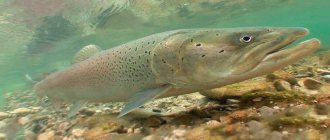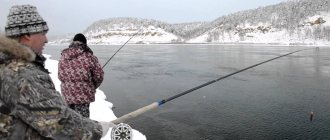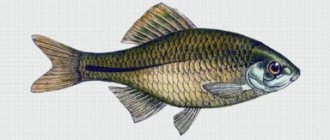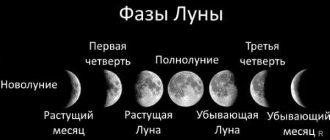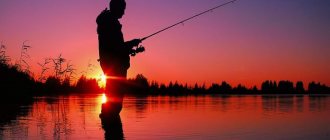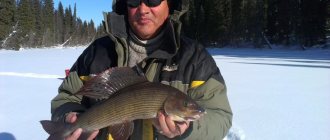Ichthyologists claim that up to 40 species of fish live in our waters. Amateur fishermen, of course, do not count that many. And this is understandable, because some small fish simply do not interest anyone. These include the verkhovka from the carp family, reaching a maximum length of 9 cm; sculpin goby, not exceeding 10-12 cm, inhabitant of rivers with clean, transparent water; loach (we call it barbel), reaching 12 cm, similar to a gudgeon, but with antennae, the body is slab-shaped, light-colored, with very small scales. No one fishes for these fish on purpose. In the summer on the lakes, the verkhovka interferes with fishing, constantly grabs the bait, drags it, knocks it down, hits the fishing line, the float. Can be used as live bait. The sculpin goby is rarely caught with a fishing rod; it hides almost all the time under stones or in other secluded places; it is a good bait for burbot. Char is sometimes caught with a fishing rod, using a dung worm. It bites in the spring, usually in company with a minnow. It is also used as live bait.
All other fish of Bashkiria are the object of fishing, of course, to varying degrees. The exception is those that are not caught with a fishing rod at all, or newcomers to our reservoirs. Every fish has new habits, its own “character”, and therefore unique fishing methods.
Chub
Fishermen once talked about baits: which one is better? We went through all the known and extremely rare ones. One of the interlocutors suddenly exclaimed: “This is all wrong.” Now I know the nozzle - you'll rock it! With it, just have time to pull out the fish. - What kind of unprecedented thing is this? — my colleagues were burning with curiosity. - Nothing special. Ordinary... cranberry. - Fi, cranberry... Will anyone take anything for it? - And how! And do you know what the important fish is? Chub, the chub itself! “Well, really,” the interlocutors doubted. - After all, you can’t even hook a berry... - But you don’t need to do that. - So how to apply it then? “It’s very simple,” said the secret keeper. - Of course, you know that chubs swim on top. So, if you see them, throw a handful of cranberries into the water. The chubs will rush towards her and immediately freeze. - How so? Why? - How why? The chub will grab the cranberry and from the unbearable acid... he will close his eyes. Don’t yawn here: take it with your hands and throw it into the boat... - ?!
Indeed, chub often stay in the upper layers of water. In clear summer weather, from a high river bank you can see how, with their beautiful red and black fins spreading, flocks of chubs bask in the sun, occasionally moving to maintain balance. At this time, as they say, it is difficult to approach the chub even with the most delicious bait. Whether you throw it from the shore, or let it from afar downstream, it won’t take it, it won’t be tempted. At such moments he is full. It goes out into the current, towards the bushes, to feed. And at this time they catch it with fly fishing on a grasshopper, a cockchafer. The chub takes the bait with a jerk, energetically, and often hooks itself.
The chub is a large, strong, very beautiful fish. Reaches a weight of 4 kilograms. The chub can be easily distinguished from other fish by its bright red anal and black caudal fins. Loves sandy, rocky, clay bottom, fast rivers with cold water.
It is most often caught under a riffle with a long fly fishing rod using a grasshopper; if from the shore, they hide behind the bushes. When there are no bushes, they cut down branches and stick them near the water. Some anglers go out on a boat with a fly fishing rod, stand on the very stream and cast the bait far. This method is also used for fishing using lures.
The chub is an extremely cautious, shy fish. Large ones do not gather in flocks. Chubs do not accumulate near the purse, and their capture from a joke, as a rule, is accidental.
The chub is caught with a donk, a worm, or with live bait. Recently, large fish have begun to be caught with spinning rods, but not with spoons, but with ordinary hooks hidden in a bread crust. The chub loves the proximity of bleak. This is confirmed when fishing with unexpected bites from chubs on a tiny bait and a small hook. In winter, chub occasionally fall on bloodworms, but best of all on sour dough.
Fishing for taimen
The optimal time for fishing for salmon is May-June (post-spawning feast) or the period from late August to November (autumn feeding). The highest frequency of bites is observed in the morning and evening twilight, when fog falls on the water surface. The fish prefers to stick to the bottom layers of rivers and lakes, so they are less likely to grab bait from the surface or in mid-water. The predator's favorite stopping places are areas near rifts and rock ridges, dumps, mouths of tributaries and streams, and small islands on reaches.
To learn more:
Salmon is a red fish from the salmon family.
Spinning fishing
It is better to refuse ultralight and light forms, which will not be able to cope with the large mass and strong jerks of the redfish - when fishing, the prey often “lights a candle”, jumping high out of the water. A rod 2.2-3.0 m long with a top weight of 50-60 g is optimal. When catching taimen, spinning rods Aiko SGP, Daiwa Whisker, Hearty Rise SYLPHY have proven themselves well. When choosing a reel, it is better to give preference to spinning or multiplier traction models with a drag load of 7-10 kg and a spool capacity of 4000 or more according to the Shimano classification. The main thread is a braided cord with a cross-section of 0.23-0.3 mm with a breaking load of 12-40 kg. To avoid accelerated abrasion of the vein on stones, you can use a fluorocarbon shock leader. The main wiring is slow.
Lures for taimen
Due to the natural caution of the predator, you should use oscillating or rotating spoons of natural colors, which are characteristic of local fish (silver, copper, brass, gold), and have a set of different-sized baits. Large taimen fish well for small Mepps Lusox or Abu Garcia Toby, but completely ignore their larger counterparts. Good results are demonstrated by sinking and diving wobblers (suspenders) and Devons with spinning blades. Steadily floating fish-shaped baits (poppers) are used extremely rarely due to their low efficiency. It is much better to catch taimen using an artificial mouse 10-12 cm long, which realistically imitates a rodent floundering in the water. Such a spoon with several tees is especially effective when catching a predator on a cloudy day or at night.
Dace
A very cute, even beautiful fish. Light, regular, so to speak, classical in shape, reaching a length of 30 cm and a weight of 400 grams. In our reservoirs such specimens are very rare; dace weighing 100-200 grams are usually caught. Large ones are almost never caught from the shore. Small dace often stay in large schools of bleak and roach and enter creeks and bays.
Many, even experienced fishermen, confuse dace with bleak, roach, chub, and even moose. But he doesn't look like any of these fish. The dace looks somehow more tender, “whiter” or something. The so-called European dace lives in our rivers. A small dace, indeed, looks like a bleak, but it is thicker than it, the back is lighter; the track is much wider than the dace, and its eyes give it away - red; the chub differs in its greater thickness, brighter fin color, and its scales are larger; The roach is much more corpulent than the dace, and darker than it. In a word, dace among these fish looks slimmer and more elegant.
Fishing for dace is a difficult matter, and I have never seen a fisherman who specifically hunted for it. The fact is that the dace is fickle in its habits. It can be found anywhere and anytime: in the morning, at lunchtime, in the evening, in a quiet backwater, in a rapid, most likely under a riffle.
It is believed that dace is a schooling fish that does not make large movements. However, based on the way he comes across, this can hardly be said. Dace is a fast, very agile fish, however, when caught, it quickly falls asleep in the cage: it does not tolerate cramped conditions.
The dace begins to peck at the dung worm in early spring. But you won’t catch more than two or three in one place. It bites better in July and August and early September.
You can fish for dace from a boat while fishing in the current. Perhaps you don’t need a purse, because when fishing with it you don’t come across dace. Fish bait: dung worm, grasshopper, fly. But best of all is the gadfly. The dace is partial to this insect. One day I was sitting on Ufimka under a riffle and doing wiring. The morning turned out to be unlucky - I caught 2-3 roaches. At about 11 o'clock in the afternoon the July heat wore off, and I wanted to break free, because no fish would take either the worm, or the dough, or the steamed grains that were in the bag.
A gadfly stung me painfully on the leg and I swatted it away with my hand. “What if we try on him,” I thought and hooked the gadfly. I threw it out, the float went only about a meter and dived vigorously. I hook and pull out a hundred and fifty grams of dace. The gadfly turned out to be almost intact, I corrected it and threw it again. The bite followed instantly, and again the dace, but larger. The gadfly was eaten, but I have not yet caught another. I baited the worm, threw it... Several retrieves - not a single bite. I take off my shirt to attract the gadflies. To my joy, they arrived and began to land on me. I caught them and immediately hooked them. The bites followed instantly.
This and other cases convinced me that it is not so important to prepare specifically for fishing for dace as to be able to adapt to catching it if it shows up.
Dace belongs to the carp family; it has extremely tender, white meat.
The most famous rivers
Fishermen of Bashkiria know that they can fish on many rivers. The White River is considered the largest, its length exceeds 1,400 kilometers. It has many tributaries, which are also famous for their abundance of fish. The following types of fish are known to live in the river:
- pike,
- zander,
- perch,
- grayling,
- burbot,
- bream,
- crucian carp,
- sturgeon,
- roach.
It is known that there are a lot of fish in the river, so there is no point in traveling far from your homeland. Standing with a fishing rod near the shore, you can catch a lot of fish in a few hours. If a fisherman is interested in predators, then he needs to look for areas of the bottom covered with snags.
This is where you can find large pikes and perches. They bite well on worms and bloodworms.
The Ai River is less known among fishermen, but locals regularly head to its banks. They know that grayling can be caught there at the height of summer. Fishermen also return home with a catch of roach, bream and perch. Bream bite well only with bait. Most fishermen mix cut worms and steamed grain to attract more fish.
The Ik River is not very long or deep, but it attracts fishermen from areas that are located quite far from it. This is due to the abundance of fish and convenient approaches to the water. The following species live in the river:
- carp,
- crucian carp,
- burbot,
- roach,
- silver bream
The Lemaz River, located in the Dumansky and Mechetlinsky regions of Bashkortostan, is also considered an excellent place for fishing. During the spring flood, the banks are covered with a layer of water, so fishing lovers in Bashkortostan are forced to stay at home during this period. In summer and autumn, the catch can be successful when using bait. Peaceful fish are lured with steamed grain, worms and bread, but predators prefer small fish.
Asp
His name is river tiger. Indeed, the asp is as beautiful and fierce as a tiger in the jungle. The asp can be very large, up to 3-4 kilograms, and therefore is a desirable trophy for spinners and anglers. It feeds on small fish, mainly bleak.
There are legends about the asp. It’s as if he takes live bait or a spoon (and a special one) only on the very surface of the water. And he hunts for small things in his own way: he runs into a school of fish, hits him hard with his tail, and then picks up the stunned one. And the asp stays, they say, only in those places where there are funnels and eddies of water.
Perhaps all this is true. However, I have more than once had the opportunity to observe the behavior and catching of asps in Ufimka. And it seems to me that some information about him is doubtful. Firstly, about the depth of its habitat. Spinning anglers catch asp, like other predators, at different depths. It is important to know its habitats. They are not difficult to identify, because the fish reveals itself with strong splashes during the morning and evening feeding. Once, in the Shakshi area, I caught a one and a half kilogram asp with a donk on which a small snare was attached. Before this, another angler caught a three-kilogram asp in the same place in the same way. These facts do not confirm only the “superficial” biting of the asp.
It is also hardly true that the asp stuns its prey with its tail. I know of one place in Ufa where the asp lives permanently, and I have been observing its behavior for many years. A dam extends up to the middle of the river, which does not protrude from the water even at low water. Therefore, a natural drain of water was formed, and behind the dam there was a not very deep, sluggish reach. It is on this that the asp rests. During the morning and evening feeding, he approaches the dam and begins hunting. No matter how much I observed, I never saw the asp somehow hit the water with its tail. He never jumped out of the water, but always chased his prey, noisily turning around in the surface layer of water. As a result, breakers and splashes appeared, but not pops. It is not clear how an asp can kill fish with its tail. He probably just swallows her, overtaking her. Apparently, unlike other predators, the asp does not use ambush, but hunts in open places and, as they say, at high speeds.
In the village I have a friend, teacher Nikolai Vasilyevich. When I come on vacation, the first thing I do is find out from him about all the fishing news in these parts. He willingly shares with me. One day I watched him hunt for an asp near that very dam. He showed me the tackle. This is a small tee on which are attached the likeness of insect wings cut out of pink polyethylene. Standing on the dam, Nikolai Vasilyevich unwinds the fishing line for about thirty meters, and then begins to ride along the dam. If there is an asp, he takes it very quickly. One day I was sitting on the shore and watching this fishing with enthusiasm. Literally five minutes after casting, the asp took the artificial fly. The fisherman slowly lowered the anchor from the boat and began to fish. “The main thing is not to rush,” he explained, “if you’ve already taken the asp, then for sure.” And indeed, Nikolai Vasilyevich lowered the line every time the asp did not want to go to the boat. However, he kept the tackle in tension all the time. About ten times the asp allowed himself to be brought close to the boat, but when he saw it, he went into the depths. Finally, the fish got tired, the fisherman slowly and carefully brought it to the boat and directly grabbed it with his hand by the opened gills. So, before my eyes, the teacher caught two large asps within half an hour. It should be noted that small asp are almost never caught, less than a kilogram is rare.
I also caught an asp at that time. Just in a different way. I went out early in the morning to go fishing with a jig. He settled down on the dam and began to cast the tackle, spreading the line out to 8-10 meters. So I caught several subs and breams. And suddenly there was such a bite that I thought: it hit me. It turned out he took a large ide. “Eh, small jig,” I thought. However, he began to catch fish. Several times I brought the ide to the boat and lowered it into the depths. And so, when he had already brought him very close, when he took hold of the prepared net, the ide came off the hook...
Having calmed down, I throw a jig baited with a fresh worm. I pulled it several times, felt a bite and an immediate disappearance of the fish. I started choosing fishing line to adjust the nozzle. And at this very time the asp grabbed the jig and decisively moved it to the side. It was shallow above the dam, and after pulling up a little, I saw the fish in all its glory. The asp was more important than the ide that had just fallen. He did not jerk like an ide, but walked with dignity to the right and left, sometimes allowing himself to be brought closer to the boat. However, he immediately retreated behind the dam, into the depths. “No, you can’t pull this out,” I thought. But, remembering Nikolai Vasilyevich’s advice, he did not fuss. If the fish goes into the depths, I lower the line, if it gives in, I bring it to the boat. Having made sure that the jig was firmly embedded in the upper lip (I could see this very clearly), I stopped worrying and rushing. The main thing is to tire the asp and slowly bring it to the boat. Finally, I succeeded, and I calmly placed a landing net under the one and a half kilogram asp... This is our local asp.
crucian carp
To some extent, this is also a mysterious fish, very picky when it comes to biting. Fishing for crucian carp here begins in early May, if spring is warm, and lasts until August, rarely until September. And everywhere it is almost the same. The best, of course, is in June. On one of these warm June days, with my long-time partner Maksimych, we hurried to the lake to get crucian carp. Experts say that this fish must be caught in a shallow grassy area. Crucian carp loves steamed crusts of bread, grain, and cake. They need to be scattered a day before in the place where you are going to fish. And just before fishing, it’s good to throw in a little crumbly porridge, say millet. The best bait is bloodworms, maggots, caddis flies, and common worms. It also works well on a roll of bread, steamed barley, and pieces of boiled pasta.
Maksimych and I did not adhere to all these rules. Firstly, we had one attachment - a dung worm. Secondly, although we spent the night by the lake, we did not feed the fish in the evening. For some reason we were confident that we would catch it anyway.
We sat for a long time by the night fire, but still got up early. At about five o'clock we inflated the rubber boats and set off to look for a lucky spot. Maksimych took a fancy to the reeds not far from the shore, growing in a semicircle facing the lake. This is where we stopped. Having settled down, we threw in a handful of porridge and began to unwind our fishing rods. Half an hour passed and there was no bite. We were worried: good times were running out. But the float of one of the fishing rods sank a little. We were wary. “You see, the crucian carp is sucking,” Maksimych whispers. “Yes,” I confirm. And then we notice how the float, diving, went to the side... Hook! And in my partner’s boat there is the first crucian carp. It's not big, but you can't say it's small either. “Yeah, they smelled trouble, they came,” Maksimych said, taking the trophy off the hook. Indeed, the crucian carp began to be taken intensively. After about an hour the biting stopped. We wait and wait, but there is no bite. Did we set the nozzle too deep? I pull out the rod and move the float to the hook, leaving less than a meter of line instead of one and a half. I cast and there’s a bite right away. Moreover, the crucian carp is quite decent. “Podlapotnik,” Maksimych called him.
The neighbor followed my example - he raised the hook. And things started going well for us again. They caught crucian carp, as fishermen say, at mid-water and often. At one time, Maksimych did not have time to manage two fishing rods: while he was pulling out one, he was removing the crucian carp from it, adjusting and attaching a new attachment, the other one was biting. I had one fishing rod, and I observed and experimented.
When it got warmer, by 9-10 o'clock in the morning the sun was shining brightly, the crucian carp rose from the bottom and began to play. Here and there, chips appeared on the surface of the water - crucian carp even jumped out of the water. They say correctly that this fish loves porridge. As soon as the bite weakened, Maksimych scattered a handful - after 5-10 minutes the crucian carp gathered and began to bite again. The crucian carp bite interestingly. You could say, each in his own way. One ingenuously twitches the float, another leads it to the side, the third, apparently, rushes to the nozzle on the move - the float dives sharply...
We noticed that these were the pranks of the kids, whom we immediately released into the lake. And here is a completely original bite: it seems that the float has decreased, but so little that you still don’t believe your eyes. However, you look closely. Yes, the float, indeed, sinks extremely quietly; So he went to the side, energetically dived under the water and moved rapidly there. Sweep! Pleasant heaviness - there is a large specimen on the hook.
We sat there and had fun. Maksimych became interested in why large crucian carp take from me more often. I have no secrets, we sit side by side, side to side, everything we do is in each other’s sight. But I think that for large crucian carp you need a larger bait. I deliberately choose a thicker worm, and sure enough, the crucian carp takes a pretty decent one. And I also noticed that he prefers a short worm, with the tip torn off.
Crucian carp strikes intensely early in the morning, weaker in the evening. It seems to me that the fishing described says a lot about crucian carp. In our reservoirs it is the same almost everywhere, it is worth noting that our crucian carp are smaller, 150-300 grams are considered large. In fact, under favorable conditions, this fish reaches large sizes - up to 45 cm long, weighing more than 3 kilograms.
White or silver crucian carp is found in our reservoirs, but much less frequently.
Usually crucian carp bite well where they live alone, and the larger the body of water, the larger the crucian carp. And one more regularity: larger crucian carp live deeper, and this is where you need to fish for it.
Popular lakes in the region
Large and small lakes attract fishing enthusiasts in Bashkiria. Every experienced fisherman knows where to go fishing. Many of them go to Lake Bannoye, which is considered the deepest in the region. Its area does not exceed 8 square kilometers, but its maximum depth is 28 meters. The shores of the reservoir are surrounded by beautiful mountains, so in the summer, lovers of outdoor activities often go there.
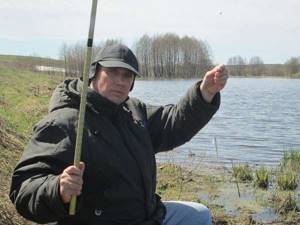
It is known that Lake Bannoye has been considered a natural monument since 1965 , but there is no ban on amateur fishing. In 1930, whitefish and peled fry were released into the reservoir. The population is growing every year, so fishermen return with a good catch. You can also find pike, perch and chebak in the lake.
Lake Aslikul is considered the largest in the region. Its area is more than 23 kilometers. The average depth is not 5 meters, but there are areas with a depth of 8 meters. The banks of the reservoir are covered with forests, so people who like to relax in the lap of nature sometimes come there. The most “fishy” places in the summer have to be taken early in the morning. The following types of fish are found in the reservoir:
- pike,
- perch,
- burbot,
- roach,
- crucian carp
Predators are caught using spinning rods, while peaceful fish bite well on ordinary float gear. Some fishermen use bait. They mix steamed millet and pieces of worms. This method allows you to increase the activity of the fish.
Lake Kyndrykul is also popular among fishing enthusiasts in Bashkiria. In winter it does not freeze completely, so some fishermen value it very much. In winter you can catch perch and pike. Other fish species are not active. In the summer, fishermen return home with a catch of peled, burbot and crucian carp.
Lake Atavdy is appreciated by fishermen from all parts of the country. That is why in the summer it is difficult to find a place to park a car, and the coolest places are occupied at 4 o’clock in the morning. In the reservoir you can see grass carp, silver carp, crucian carp, tench and perch.
Lake Bursunsy is not very popular among fishermen and outdoor enthusiasts as it is located far from large cities. Sometimes fans come there to play paintball, but this does not happen too often. Fishing enthusiasts choose areas with convenient approaches to the water. They say that there are a lot of fish in the reservoir, but they only bite when using bait. You can return home from the reservoir with a catch of carp, perch and ide.
Bream
This fish is the object of not only amateur fishing, but also commercial fishing. It is caught almost throughout the year, excluding the winter months. They fish at different times, in different ways. The best time for bream fishing is summer, from May to September.
Almost every angler fishes for bream, or rather bream. Bream is quite common in our rivers, lakes, and reservoirs. Fishing him is not considered difficult, he is well fed, and gathers at the purse. And that’s why he’s usually caught in the wire. With a good bite, say, on Belaya, the bream takes it so well that fishing it turns into mechanical pulling. This is also because the bream is humble; when fishing, especially when quickly, it hardly resists.
Bream is very widespread, which indicates its unpretentiousness. It lives in bodies of water with a hard bottom and relatively warm water. It is usually found in lakes and in places with a sandy, silty, clayey bottom, in rivers on deep reaches with a galley or, as fishermen say, a gristly bottom, as well as near clayey ravines.
The usual size of bream, which becomes a trophy for anglers, is 0.5-1.5 kilograms. And if it’s less than half a kilogram, then it’s a bream. The large silver bream is often confused with it. However, an experienced fisherman can distinguish it: it is lighter in color, has a shortened anal fin, and rarely weighs more than 200-300 grams.
In the fishing community you often hear this name - sapa. And in fact, there is some kind of bream in our waters. It is somewhat longer, more transparent than bream and at the same time does not look like a silver bream. Some claim that this is a natural hybrid of bream and silver bream.
But let's get back to the bream. In the literature, for example, in the academic publication “Animal Life” it is stated that bream reaches a length of 45 cm and a weight of 2.5-3 kilograms. It would be more accurate to consider this weight as average. Our reservoirs are inhabited by specimens weighing 4-6 kilograms. I myself had to catch bream heavier than 3 kilograms.
The success of fishing for bream is primarily ensured by knowledge of its habitats and the characteristics of its behavior. In some ways, bream is considered a nocturnal trophy. However, in our area, rarely does anyone hunt at night. Usually bream feeds in the morning and evening dawns and is well caught with a fishing rod at this time. Bream should be looked for in deep holes, near algae and reeds. On the river this is not necessary - there it even reaches relatively small reaches, stands under rifts, near rocky and clayey banks.
They begin to fish for white bream in February using a jig, the attachment is a bloodworm brush. In the spring, in March and April, the bite can be, one might say, intense, if you find a spot for a bream. During spawning, in May and June, the bite continues, and then comes the most catchy time for fishing with fishing on the river and float casts in lakes. In lakes it is best to use hooks No. 7-9, fishing line 0.4-0.5 mm. Usually the nozzle is placed on the bottom and a light sinker is adjusted so that it rests on the bottom, just tilting the float slightly. You need to cast further from the boat. Lesh lifts the nozzle from the bottom - the float goes down. There is no need to rush. When the fish confidently moves the float, hook. The nozzle is a worm lobe. Sometimes it is better to use what you throw in as complementary food: steamed grains of oats, wheat.
Fishing in Bashkiria
Bashkiria (Republic of Bashkortostan) is famous all over the world for its numerous rivers, so fishing in Bashkiria is simply ideal. There are over 600 such reservoirs throughout the republic, so there are plenty of fish species here.
If you study all the features of the area and water area in advance, you can safely count on a rich catch.
Table of contents
— Fishing in the Region ↓ — Features of Bashkir fishing ↓ — Winter fishing in Bashkiria ↓ — Add a fishing spot to the map ↓
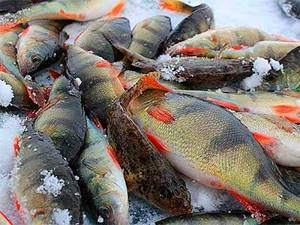
237 kilograms of fish from one hole!
The detained fishermen told the secret of a good bite. The fishery inspectors were surprised by the lack of prohibited equipment...
Read more
The main thing is to know the habits of the local fish, the optimal bait and tackle, then even without much skill you will be able to catch a decent trophy. Many tourists come here specifically for fishing “hunts”.

Tench
This was perhaps the most exciting fishing ever. My friend and I arrived on a July evening at Lake Bessonnoye. We quickly pitched the tent and got into the rubber boats. We drove about 50 meters from the shore. The depth is about 2 meters (to the grass that covered the bottom). We stood at the stakes opposite each other at a distance of 5-10 meters. I unwound it, baited two float rods with an ordinary worm, cast it and began to wait for a bite. Probably twenty minutes passed, and the float did not move. And suddenly - slowly, but, as they say, surely he went under the water. I hook and feel: the fish is big and stubborn. At first I can’t even move it. Finally I fish it out and am surprised - about half a kilogram of tench!
Of course, I thought it was random luck. But not even ten minutes had passed before the tench began to bite again. I only had to fish for an hour and a half before dark, and I managed to catch about a dozen tench of different sizes, but not a single one smaller than 200 grams. And what’s surprising is that my friend didn’t catch a single tench.
In the evening we cooked an excellent fish soup, took a nap, and in the morning we were back in our places as soon as it was light. 10-15 minutes after the first cast, a tench bit me, soon a second, a third... And off we went. My friend wasn't biting again.
My bite was steady and even. I realized that I had hit a happy place. The bites followed almost at regular intervals of 15-20 minutes. Lin took it seriously, methodically, truly. And it seems there was not a single meeting. Fortunately, I had a landing net and brought it under the fish at a depth of half a meter.
There was another angler sitting about thirty meters to my left, and he wasn’t catching anything. At first, my colleagues cursed, made all sorts of adjustments, and then got carried away by watching me. Indeed, it was an amazing, extraordinary fishing trip. I found that I only got bites on one fishing rod, the one I cast from the starboard side. Yesterday the fishing rod stood calmly on the left side and there were no bites today. Then I noticed another interesting circumstance. It turns out that the bites on the right fishing rod followed in a strictly defined place.
Have I really hit the fish trail that people talk about so much?
Perhaps. In any case, for some reason the tenches came to this unfed place, although, as is known, they usually stay alone.
It wasn't until about nine o'clock that I finally saw a bite on my left rod. And again I was surprised: instead of the expected tench I pulled out a large silver crucian carp. At first I thought: is it bream? But no, it turned out - crucian carp. I caught three more goldfish on my left fishing rod. As far as I remember, only one tench was hit, probably because for some reason it went off the path. At about ten o'clock the wind rose and excitement began. However, the tench continued to peck, albeit less frequently. I had to go home, and I was laid off.
Tench is found in our reservoirs. For example, in Maksimovskoye, Melnichnoye, Lomonosovskoye lakes near Ufa, in lakes Yesen, Manat, Kandrykul and many others. This fish loves quiet, deep places and muddy bottoms. Its thick, fleshy body is covered with small scales. The back is usually dark green, the sides are golden-green. Tench reaches 60 cm in length and more than 7 kg in weight. Such giants are rare in our reservoirs. One fisherman told me how he hooked a four kilogram tench on Maksimovskoye Lake. It was not possible to pull him out immediately. The fisherman threw his rod into the water and it floated to the opposite shore. The fisherman overtook him and tried to pull him out again, but the line headed back, so he had to let go of the rod again. Only for the third time did the fisherman manage to lift the fish from the bottom, and then he saw a huge tench in all its glory. There was no landing net; an attempt to pick up the line by hand ended in failure. The leash broke. Lin went into the depths.
In our reservoirs, tench usually weigh 200-500 grams, rarely larger. They don’t go out to fish for this fish specifically, since it’s difficult to predict where and when it will bite. Some fishermen on lakes clear the bottom of grass in one place and throw in porridge, bread, and worms a day or two before fishing. And then, along with crucian carp and other fish, tench is often caught, usually in good summer weather. The best bait for tench is a dung worm. Hook No. 6 is used, preferably forged. Tench have thick, fleshy lips. It takes thoroughly; you should not rush when biting. Often the tench begins to approach the bait slowly. Looking at the float, you notice its “dancing”, some kind of trembling. If the weather is calm, this causes small, barely noticeable circles around the float. Then the float will dive timidly, then more confidently and move to the side. This is where you need to hook.
Usually, hooking at the first moment causes a feeling of a slight hit. They say that when a tench bites, it holds its head down and therefore it is difficult to lift it at the first moment. But hold the line under tension for a few seconds, and the line will move. Although they say that this is a sluggish, sedentary fish, when fishing, tench behaves quite violently. It is risky to pull it out without a landing net, especially a large one.
And finally, about taste. Tench is a desirable fish for the owner. And the fish soup, and the roast, and the pie made from it are excellent. Tench is tasty, meaty, has no bones in its body, and is easy to clean. There is no need to remove the small lumpy scales from the tench. After gutting, wash off the viscous mucus and put it in a cauldron - the scales quickly dissolve in boiling water.
There is a belief among fishermen that tench mucus has healing properties and that fish with bleeding ulcers rub near the tench, healing their wounds.
Burbot
Everything about him is unusual: his appearance, his lifestyle, and the timing of his bite. Ichthyologists believe that this is the only cod species that moved from the sea to fresh waters. In our rivers, burbot leads, in comparison with other fish, a kind of reverse, opposite lifestyle. When all the fish have a good bite, it doesn’t take at all, when in severe frosts, in the so-called deep winter, all the fish become lethargic, almost don’t take even the most tempting bait, the burbot begins to eat, and spawning occurs. In a word, as unusual as it is in appearance, it differs from other fish in its habits.
Burbot loves clean, cold waters and is usually found on rocky soils. In the summer it hibernates, hiding under stones, snags, and in depressions. And don't expect him to take the bait. The only way to catch it is with a fork. Yes, yes, an ordinary fork. As a child, I remember we wandered through the rifts of Ufimka with a fork and kukan in our hands. You go in so that the water is above your knees, below your waist, and start turning over stones. Sometimes you turn the stove over and you can’t believe your eyes - there’s a black pile of about one and a half kilograms lying there. You stick a fork in his back, grab him with your other hand from below - and onto the shore. But this is child's play. In general, burbot is most often fished for at night using donks. They put crawling worms, minnows, ruffs, and pieces of stale meat on large hooks. They catch it from under the ice using a spoon baited with pieces of fish.
There are more than twenty species of burbot; we have the so-called common burbot. This is a predatory, voracious fish. There are various tales about his gluttony.
I have a friend who seems to be interested in fishing, and at the same time treats fishing stories with irony. This is apparently because he doesn’t like to bother with a lot of fishing rods, which are usually used to catch a decent fish. One day he comes running to me in indescribable delight: “I found, discovered a new way of fishing!” Extractive - wow! - shows me his thumb. “Some kind of poacher,” I say. “On the contrary, he’s very noble,” the neighbor admires, “and most importantly, he’s not troublesome.” You serious fishermen, how do you go after burbot! Take a lot of fishing rods with bells. Sit all the time, listening when it bites and rings. - Right. What, do you fish without fishing rods? - Almost. In any case, I manage alone and even without a bell. And I always come with a catch. I take a thicker line and a smaller hook. I bait it with a worm, throw it in the evening and sleep until the morning. At dawn I pull out my fishing rod, and you see - there’s a burbot at the end... - Well, these are fables. - But no. Do you want to know how it turns out? - Very simple. The greed of burbot is known. Everything is built on it. The small burbot takes the bait first and is hooked. Then a larger burbot approaches. Wants to swallow its smaller brother. Naturally, sensing itself in the role of prey, the small burbot begins to squirm intensely in the mouth of the big one, making a desperate attempt to free itself. And it doesn’t fit into the throat when bent. Finally, the tail and then the body fall into the gills of the burbot, which continues its work. So, gradually or in one fell swoop, the victim crawls entirely into the gills of the burbot, which ends up on the kukan. Well, then it will go in the same manner...
The burbot caught in our reservoirs is usually small, 100-300 grams, rarely 1.5-2 kilograms. They say that in Siberia there are giants up to 24 kilograms.
Podust
Early in the morning you came fishing. We swam out to the middle of the reach, laid up, lowered the purse... A quarter of an hour passes, perhaps more, but there is no bite. But then you notice that below the boat, right on the fairway, splashes and ripples appear every now and then. Now they are already everywhere around the boat, and it seems that the whole river is boiling from these splashes. They are only absent around the boat within a radius of 15-20 meters. Naturally, you hope for a catch, let the fishing rod move further away, and change the bait. But in vain, there are no bites.
Know that this is a herd of podust walking. Of course, you continue to hope for a bite. But dawn passes, the splashes stop, and there is not a single fish in the cage.
Don't be upset. Be glad that you had to witness such an extraordinary spectacle. Leave early tomorrow too, because everything can change. The fish is so hungry that it is impossible to predict how it will behave in an hour, two, or a day.
This is how he behaves in the summer, especially in the hot season - in July and August. Sometimes the podust suddenly starts to take over, and so intensely, you just have time to turn around. Fishing for bass, especially large ones, is incomparably more exciting than catching any other fish. Podust is an extremely energetic, strong and beautiful fish. He takes it correctly, resists with passion and ingenuity. An experienced fisherman who has fished a lot under bait immediately feels that he is the one on the hook. Firstly, it is difficult for the pod to “come off” from the bottom, and when raised in mid-water, it begins to perform aerobatics: it will sharply move to the side, then it will throw itself under the boat, or it will begin to roll over. He is a master at such tricks. Now you can already see it in the water - dark upper, bright red lower fins, a classically beautiful appearance of a fish. But hey, don't think he's already yours. In front of the boat, the podust behaves violently and can easily get off the hook by unexpectedly jerking to the side or somersaulting. A landing net with a two-meter handle can prevent these things.
Podust best catches dung worms at dawn. Moreover, when fishing with a float, the depth must be adjusted so that when fishing, the nozzle touches the bottom, or even drags along it. Podust usually lives in the middle reaches, on a rocky, gravelly bottom. It also bites on maggots, caddisfly larvae, shell meat, and steamed grains. Its good bite is observed from June to early September. In March-April it bites on a jig baited with bloodworms. When they fish with a purse, they put buckwheat porridge in it; They say the podust is very partial to her. Since spring, this fish is most often caught on the donk.
When angling underfish, an important circumstance must be taken into account: the hooks used are small but strong, the so-called forged ones. The fact is that the podust, unlike all other fish, has a small mouth, directed downwards, and is a transverse slit. And this circumstance contributes to a good hook, since the upper lip of the undermouth is very massive.
Podust feeds on algal growths of stones. One day I watched him feed from a boat. He will stop over the stone and begin to examine it, quite energetically, with his whole body, turning, diligently “hollowing” the stone, probably scraping off algae with his sharp lower lip.
Podust is a schooling fish, and stays in very large colonies. It reaches a length of up to 40 cm and a weight of up to 1.6 kilograms. True, such specimens are almost never found in our reservoirs. The most common weight is 200-300, rarely 500-700 grams. We live in the so-called common podust; it belongs to the carp family. The inside of his abdomen is black. Podust is an excellent fish for drying.
Ide
Every fisherman knows him. Ide is an unpretentious fish, found everywhere: in rivers, streams, lakes, and reservoirs. Inexperienced fishermen easily confuse it with a chub and even with a magpie. But it differs from the chub by having a smaller head, being more stout, or something - its belly somehow sags. The coloring of the ide is similar, but its coloring is less contrasting, although the colors are the same, only there is no dark edging on the fins. The small ide is confused with the track.
Ide is not a schooling fish, but quite collective. It feeds very easily, gathers near the purse and bites quite faithfully.
The most productive way to fish for ide is by retrieving; it bites well on float and bottom fishing rods in deep places, on stretches. The best bait for it: a worm, steamed grains (especially peeled oats), oatmeal pellets, bark beetle larvae, grasshoppers.
The ide catches and catches excellently in June and July. In feeding areas there are quite large specimens, 2-3 kilograms each. I had to fish out ides up to 3 kilograms, one of them was caught on a spoon. A large ide becomes a predator, catching fish and spinning rods.
The best time to catch ide is early morning, sometimes in the evening; in a well-fed place it bites all day, of course, at different intervals. Favorite habitats are near grass, bushes, on deep reaches of rivers, in flood lakes, and in the channels between them.
When fishing, the ide suddenly grabs a hook and a hook for a fly or bread from a raft. Since the tackle is usually weak, fishing often ends in the line breaking off. To take revenge, switch to wiring or bottom fishing rods thrown from the raft.
Winter Fishing in Bashkiria
If you decide to fish in Bashkiria in winter, then you will be lucky enough to catch crucian carp, pike and perch. Also, winter fishing will delight you with the presence of pike perch and other fish.
In any case, you will be guaranteed positive emotions, since the republic itself is distinguished by its landscapes and unusual nature.
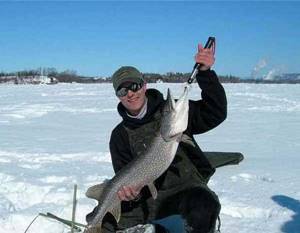
Local experienced fishermen have long been able to study all the habits of fish during the winter season. You can use the services of hunting fishing tours, where the guides themselves will select the ideal fishing spot for you.
Ruffs, rudd and perch are caught using girders, and if you follow all the recommendations correctly, then excellent results await you.
In winter, you can use other fishing options, for example, a regular fishing rod will be the optimal solution. Dough made from parsley decoction is suitable as bait. And it’s better to “hunt” burbot at night, using worms.
